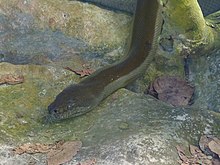Apodora
| Apodora | |
|---|---|

| |
| Scientific classification | |
| Domain: | Eukaryota |
| Kingdom: | Animalia |
| Phylum: | Chordata |
| Class: | Reptilia |
| Order: | Squamata |
| Suborder: | Serpentes |
| Family: | Pythonidae |
| Genus: | Apodora Kluge, 1993 |
| Species: | A. papuana
|
| Binomial name | |
| Apodora papuana | |
| Synonyms[2] | |
| |
Apodora papuana is a species of python, commonly known as the Papuan python, Irian python or Papuan olive python. It is found in New Guinea.[3] It is the only species in the genus Apodora.[4] No subspecies are currently recognized.[3][5]
Description
[edit]The Papuan python is a large snake, with adults growing to an average length of 4 meters (13 ft)[6] and some specimens growing to lengths of over 5 meters (16 ft).[citation needed] However, they are not nearly as heavy-bodied as most other pythons, typically weighing only about 22.5 kilograms (50 lb).[6] The available information about the species size is limited.[7] They are noted for having the ability to change color, though the exact mechanism and reasons for it are not completely understood. The color is reputed to change when the snake is agitated. They can vary from black to a mustard yellow, but are normally an olive green in appearance when young and dark olive when older, with the sides and underside distinctly lighter.
Distribution and habitat
[edit]Papuan pythons are found in most of New Guinea, from Misool to Fergusson Island. The type locality given is "Ramoi Nova Guinea austro-occidentiali" (Ramoi, near Sorong, Irian Jaya, Indonesia).[2]
Behavior
[edit]The Papuan python is largely terrestrial and mostly nocturnal. Despite their size and impressive strength, they are relatively inoffensive animals and are not prone to bite even if handled.
Feeding
[edit]Their diet consists primarily of smaller mammals, but they are also known to be partly ophiophagous.[6]
Captivity
[edit]The Papuan python is not commonly available in the exotic pet trade, and when they are available they command high prices. They are a relatively hardy species that adapts well to captivity, readily feeding in commercially available rats. Captive breeding has been done.
References
[edit]- ^ Tallowin, O.; O'Shea, M.; Parker, F. (2018). "Apodora papuana". IUCN Red List of Threatened Species. 2018: e.T13300623A13300631. doi:10.2305/IUCN.UK.2018-2.RLTS.T13300623A13300631.en. Retrieved 11 November 2021.
- ^ a b McDiarmid RW, Campbell JA, Touré T. 1999. Snake Species of the World: A Taxonomic and Geographic Reference, vol. 1. Herpetologists' League. 511 pp. ISBN 1-893777-00-6 (series). ISBN 1-893777-01-4 (volume).
- ^ a b Apodora papuana at the Reptarium.cz Reptile Database. Accessed 11 November 2021.
- ^ Apodora at the Reptarium.cz Reptile Database. Accessed 11 November 2021.
- ^ "Apodora". Integrated Taxonomic Information System. Retrieved 9 September 2007.
- ^ a b c de Groot, Michael (2015). "Apodora Papuana: Papuan Olive Python". Pythonidae. Archived from the original on 2018-05-14. Retrieved 2016-02-09.
- ^ Murphy, J. C.; Henderson, R. W. (1997). Tales of Giant Snakes: A Historical Natural History of Anacondas and Pythons. Krieger Pub. Co. pp. 2, 19, 37, 42, 55–56. ISBN 0-89464-995-7.
Family Pythonidae | |
|---|---|
| Antaresia | |
| Apodora | |
| Aspidites | |
| Bothrochilus | |
| Leiopython | |
| Liasis | |
| Malayopython | |
| Morelia | |
| Nyctophilopython | |
| Python | |
| Simalia | |
| Liasis papuanus | |
|---|---|
| Apodora papuana | |
| Apodora | |
Text is available under the CC BY-SA 4.0 license; additional terms may apply.
Images, videos and audio are available under their respective licenses.

